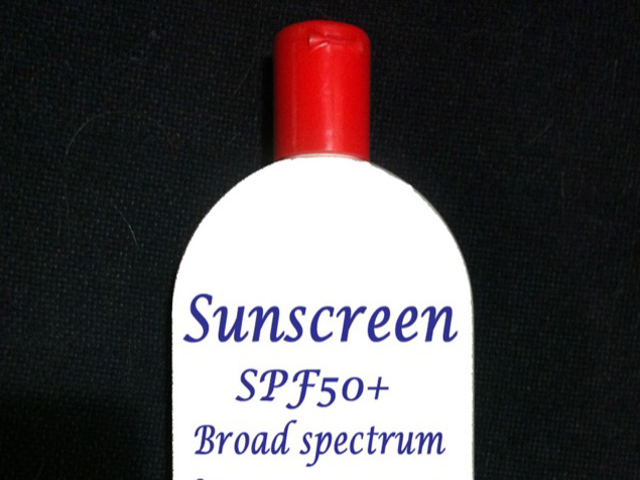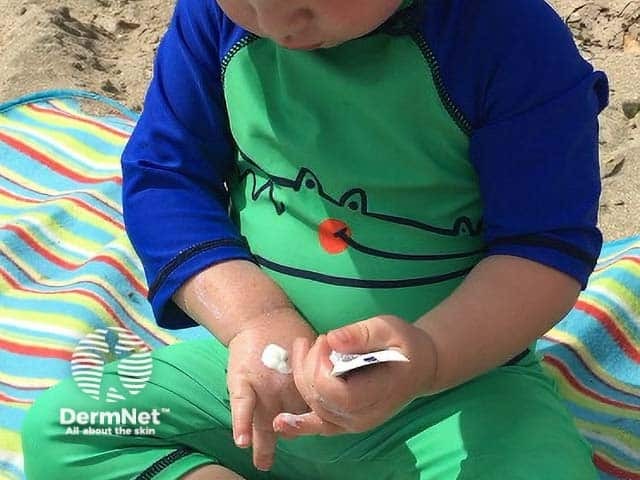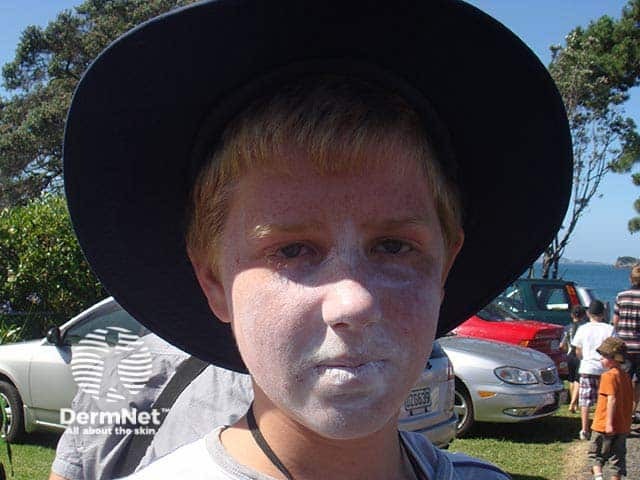Main menu
Common skin conditions

NEWS
Join DermNet PRO
Read more
Quick links
Authors: Dr Libby Whittaker, Medical Writer, New Zealand (2023)
Previous contributors: Dr Louise Reiche, dermatologist (2007); Vanessa Ngan (2005-2012); Dr Amanda Oakley, dermatologist (2013); Dr Helen Gordon (2020)
Reviewing dermatologist: Dr Ian Coulson
Edited by the DermNet content department
Introduction
Uses
How they work
Types
Ingredients
Protection ratings
Testing
Labelling
Selection
Application
Benefits
Disadvantages
Side effects and risks
Other safety considerations
Contraindications
Sunscreens are topical agents that can be applied to the skin to protect against ultraviolet (UV) radiation.
Exposure to UV radiation (UVR) contributes to skin ageing and is the main cause of skin cancer (eg, basal cell carcinoma, squamous cell carcinoma, and melanoma). Sun protection methods, including sunscreen and sun protective clothing, are important in reducing these damaging effects.
The term ‘sunblock’, previously synonymous for sunscreen, is now considered misleading given that no sunscreen ‘blocks’ 100% of UVR.

Use before going out and every 2 hours, and of sufficient thickness to maintain the high SPF

Develop the habit early on!

Modern sunscreen have micronised mineral contents and chemical absorbers that are less apparent
Ultraviolet (UV) radiation can be classified as ultraviolet A (UVA), ultraviolet B (UVB), and ultraviolet C (UVC). Solar UVC (wavelength 100–280 nm) is absorbed by the Earth’s atmosphere.
Sunscreen is used to protect the skin against the harmful effects of UVA and UVB radiation that reach the earth’s surface (see below for Benefits of sunscreen). It is recommended to apply sunscreen daily when the UV index is forecast to reach 3 or higher.
UVA |
UVB |
||||||
|---|---|---|---|---|---|---|---|
Wavelength (nanometres) |
|
|
|||||
Exposure |
|
|
|||||
Effect on skin |
|
|
|||||
Chemical sunscreens work by absorbing UVR.
‘Physical’ sunscreens (also called inorganic filters, ‘blockers’, or mineral-based sunscreens) were previously thought to reflect or scatter UVR. Studies have since shown that, like ‘chemical’ sunscreens, they provide UV protection primarily via absorption of UVR.
The most common physical sunscreens contain inorganic metal oxides, titanium dioxide, or zinc oxide, which:
Microsized or ultrafine grades (‘nanoparticles’) of titanium dioxide and zinc oxide have improved ease of application and cosmesis, and reduced white residue on the skin. Potential toxic or carcinogenic effects of nanoparticles have been raised, however, no adverse effects have been demonstrated. The established benefits of sun protection are considered to outweigh these theoretical risks.
Sunscreens can also be considered either primary or secondary. In primary sunscreens, sun protection is the main function; while in secondary sunscreens (eg, makeup) it is not.
Table 2 provides information on different sunscreen ingredients (non-exhaustive) and the protection they offer against UVA and UVB radiation. Many sunscreen products contain combinations of ingredients to optimise UV protection and photostability.
Chemical |
UVB (290–320 nm) |
UVA II (320–340 nm) |
UVA I (340–400 nm) |
|||||
|---|---|---|---|---|---|---|---|---|
Aminobenzoic acid derivatives |
||||||||
Para-aminobenzoic acid (PABA) |
Partial |
None |
None |
|||||
Glyceryl PABA |
Partial |
None |
None |
|||||
Padimate O (octyl dimethyl PABA) |
Partial |
None |
None |
|||||
Roxadimate |
Complete |
Partial |
None |
|||||
Benzophenones |
||||||||
Dioxybenzone |
Complete |
Complete |
Partial |
|||||
Oxybenzone |
Complete |
Complete |
Partial |
|||||
Sulisobenzone |
Complete |
Complete |
Partial |
|||||
Cinnamates |
||||||||
Octocrylene |
Complete |
Partial |
None |
|||||
Octyl methoxycinnamate (octinoxate) |
Complete |
None |
None |
|||||
Ethoxyethyl p-methoxycinnamate (cinoxate) |
Complete |
Partial |
None |
|||||
Salicylates |
||||||||
Homomenthyl salicylate (homosalate) |
Partial |
None |
None |
|||||
Ethylhexyl salicylate (octyl salicylate / octisalate) |
Partial |
None |
None |
|||||
Trolamine salicylate |
Complete |
None |
None |
|||||
Other chemical sunscreen ingredients |
||||||||
Avobenzone (butyl methoxydibenzoylmethane) |
None |
Complete |
Complete |
|||||
Ecamsule (terephthalylidene dicamphor sulfonic acid; Mexoryl SX) |
Partial |
Complete |
Complete |
|||||
Methoxypropylamino cyclohexenylidene ethoxyethylcyanoacetate (MCE; Mexoryl 400) |
None |
None |
Complete |
|||||
Ensulizole (phenylbenzimidazole sulfonic acid) |
Complete |
Partial |
None |
|||||
Bemotrizinol (Tinosorb S) |
Complete |
Complete |
Complete |
|||||
Bisoctrizole (Tinosorb M) |
Complete |
Complete |
Complete |
|||||
Metal oxides |
||||||||
Titanium dioxide |
Complete |
Complete |
Partial |
|||||
Zinc oxide |
Complete |
Complete |
Complete |
|||||
Note: recent proposed sunscreen regulation changes by the FDA (2019 and 2021) affect some of the above ingredients. Specifically:
These are ingredients added to sunscreens designed to enhance photoprotection by modulating the skin’s biological response to solar radiation. There are over 2000 ingredients, but the evidence to suggest for most, their effectiveness is weak.
L-ascorbic acid, photylase, nicotinamide, epigallocatechin gallate, tocopherol, isobutylamido thiozolyl resorcinol and N-acetyl cysteine may offer some benefit.
Some chemical sunscreen ingredients have been banned in certain locations (eg, Hawaii, the US Virgin Islands, and Palau), due to concerns about the negative effects on coral reefs. These include:
In these locations, mineral sunscreens (zinc oxide and titanium dioxide) are generally preferred. Check local regulations for specific details and the most up-to-date information.
Sunscreen ratings include information about protection against UVA and UVB protection. Sun protection factor (SPF) ratings pertain primarily to UVB protection as UVB is the primary cause of sunburn.
Sun protection factor (SPF) is the ratio of the UV radiation dose it takes to cause a barely detectable sunburn on a person treated with a sunscreen product (coverage of 2 mg/cm2) compared to that required for untreated skin.
While the length of exposure that results in sunburn varies between individuals, a way to conceptualise what the SPF number on a sunscreen product means is to think of it in terms of ‘difference in time to sunburn’. For example, if it takes 10 minutes to burn without sunscreen, skin protected with SPF 15 sunscreen (sufficiently applied) would be expected to take ~15 times as long to receive the same sun-burning UV radiation dose (ie, 150 minutes).
Accumulating sun-burning dose (%) over time with different SPF sunscreens*
SPF value |
10 mins |
30 mins |
150 mins |
|---|---|---|---|
1 (no protection) |
100% |
100% |
100% |
15 |
6.7% |
20% |
100% |
30 |
3.3% |
10% |
50% |
50 |
2% |
6% |
30% |
*Assumes application of 2 mg/cm2. In reality, many people do not apply this amount of sunscreen so the expected sun protection may not be achieved.
More evidence about UVA-induced skin damage prompted a focus on methods to determine UVA protection, often referred to as a sunscreen’s ‘broad spectrum’ performance.
While there is no universally agreed standard for testing and measuring UVA protection, most countries have moved away from the in vivo persistent pigment darkening (PPD) method and now use in vitro methods.
Measures include UVA protection factor (UVA-PF) and critical wavelength (CW).
Due to ethical concerns about in vivo testing, in its 2006 Recommendation 2006/647/EC the European Commission encouraged the sunscreen industry to develop in vitro testing methods for both UVB and UVA protection.
Currently, SPF testing is still done using in vivo methods, such as the international standard ISO 24444.
Several in vitro testing methods are in development; the in vitro ‘double plate’ method (ISO Committee Draft 23675) and the hybrid diffuse reflectance spectroscopy method (ISO Committee Draft 23698) are in the final stages of international standardisation. These should become the first published ISO standards for in vitro SPF testing in the next few years.
Region |
Methods for testing UVA protection |
|---|---|
Australia / New Zealand |
|
European Union |
|
United Kingdom |
|
United States of America |
|
Canada |
|
*UVA-PF: ultraviolet A protection factor; CW: critical wavelength
Methods for testing sunscreen water resistance vary internationally, and include:
Testing currently involves in vivo protocols, as SPF is measured after immersion for the specified time period.
UVB and UVA ratings provide information for sunscreen labelling, so consumers can identify which products offer the best protection. Although category and labelling descriptions vary, Australia/New Zealand, Europe, the United States, and Canada are closely aligned.
The terms ‘sunblock’, ‘waterproof’, or ‘sweatproof’ are considered inaccurate and misleading and no longer permitted on sunscreen labels.
Specific labelling guidelines are provided in Table 5 below. Cited guidelines may be updated or replaced; checking with the relevant body for the most up-to-date information is advised.
Region |
UVB |
UVA |
Water resistance |
|---|---|---|---|
Australia / New Zealand |
SPF value (minimum SPF 4; maximum allowed labelled value SPF 50+, for products with SPF ≥60 only) |
‘Broad spectrum’ label (optional; if UVA-PF ≥ 1/3 SPF and critical wavelength ≥370 nm) |
‘Water resistant’ qualified by duration (up to maximum of 4h) |
Europe |
SPF value (minimum SPF 6) |
UVA logo (the letters ‘UVA’ printed inside a simple circle) if UVA-PF is at least 1/3 of the labelled SPF and critical wavelength is at least 370 nm (recommended minimum level of protection) |
‘Water resistant’ or ‘Very water resistant’ |
USA |
SPF value (minimum SPF 2) |
‘Broad spectrum’ (optional; if critical wavelength ≥370 nm) |
‘Water resistant (40 minutes’ or ‘Water resistant (80 minutes)’ (optional) |
Canada |
SPF value (minimum SPF 2; SPF >50 to be labelled as SPF 50+) |
‘Broad spectrum’ (optional; if critical wavelength ≥370 nm) |
‘Water/sweat resistant’ 40 or 80 minutes (optional) |
Category descriptions to indicate the overall degree of sun protection conferred (low, medium, high, or very high) are also recommended for sunscreen products in Australia/New Zealand and the EU. Table 6 provides details on what these categories mean.

*As per AS/NZS 2604:2021 and European Commission Recommendation (2006/647/EC)
**Select secondary sunscreen products (lipsticks and colour cosmetic products eg, tinted bases or foundations) are exempt from the UVA requirement as per AS/NZS 2604:2021
General recommendations for selecting an appropriate sunscreen based on particular characteristics and conditions are outlined below in Table 7.
Characteristics/conditions |
Considerations for sunscreen selection |
|||
|
||||
|
||||
|
||||
|
||||
Oily skin or prone to acne |
|
|||
If active outdoors or swimming |
|
|||
Windy conditions |
|
|||
Sunscreen for specific body areas |
|
|||
Pregnancy and breastfeeding |
|
|||
Infants and babies |
|
|||
Children |
|
|||
Sunscreen is particularly useful for those with fair skin such as skin phototypes I, II, and III.
The benefits of wearing a broad-spectrum sunscreen include:
Many people do not apply sufficient sunscreen to optimise sun protection.
No sunscreen blocks 100% of ultraviolet radiation or is fully waterproof or sweatproof.
Some sunscreen formulations or products may be less preferable depending on skin type or cosmetic appearance. Fortunately, there are a range of sunscreens available.
Some chemical sunscreens may impair coral reef growth and contribute to coral bleaching.
Many sunscreens that protect against UVR do not protect against visible light. Those with photodermatoses triggered or aggravated by visible light (eg, melasma, postinflammatory hyperpigmentation, solar urticaria, cutaneous porphyrias, and some cases of chronic actinic dermatitis) should consider using tinted sunscreens (eg, ‘Dundee cream, available in 3 different colours’) which contain non-micronised titanium dioxide, zinc oxide, and iron salts, as only sunscreens that remain visible on the skin will photoprotect against visible light.
Sunscreens have potential side effects (see below).
Common side effects include:
Less commonly, allergic contact dermatitis may develop due to a sunscreen component, eg, a fragrance, preservative, or a sunscreen chemical.
Sunscreen allergy has been reported to individual sunscreen agents including PABA, benzophenones, cinnamates, salicylates, avobenzone, ecamsule, ensulizole, bemotrizinol, and bisoctrizole. This may be either an allergic or a photocontact reaction.
The FDA has proposed that PABA (aminobenzoic acid) lose its status as GRASE (generally recognised as safe and effective) due to safety concerns including significant rates of allergic contact dermatitis and photocontact dermatitis, and cross-sensitisation that may cause allergies to other medications (eg, sulfonamides antibiotics, thiazide diuretics, and some local anaesthetics). PABA use in sunscreen products is now less common.
Research into the clinical significance of these findings is ongoing. The FDA has proposed that further information is needed prior to regarding these and other sunscreen agents (except zinc oxide and titanium dioxide) as GRASE (generally recognised as safe and effective). However, this does not conclude that sunscreens are unsafe for use, even after decades of use, no adverse effects have been identified and the benefits of sun protection should remain a priority.
Trolamine salicylate has been associated with cases of systemic absorption and adverse reactions including increased bleeding risk and salicylate toxicity. It is no longer commonly used in sunscreen products and has been proposed to lose its GRASE status.
Safety queries relating to zinc oxide and titanium dioxide ‘nanoparticles’ have been raised regarding reactive oxygen species, the potential for systemic absorption, and possible associated carcinogenicity. Research in this area is ongoing.
To date, no adverse effects have been demonstrated and the general consensus is that the well-established benefits of sun protection outweigh any potential long-term risks.
For more information, see Vitamin D.